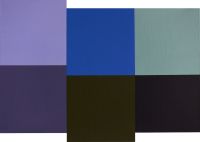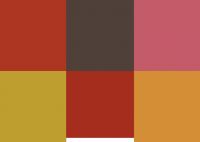














































The developments in 1977 basically comprise a return to classical compositions in order to achieve more freedom in the management of color. The location of color can now play a role again. Because of this a further possible decision is gained. The parameters are hue, luminosity and saturation in respect to color; quantity and expansion in respect to the utilization of color. In addition to the parameter of utilization is the location of color. Should a certain color be placed closely to or farther away from another color? Such decisions are made in view of the overall color effect and picture effect. The bearer of the color is no longer a structural element within a pattern, rather a form so neutral that it is actually perceived less as a form and more as a zone or expansion room of color: the square. Multiple colors in the picture are now multiple squares of color zones. The format is chosen so that a predetermined number of square zones, mostly six, do not completely fill the format. The leftover area is reserved for white. Through the placement of color zones, the distribution of white is determined simultaneously. Consequently, the organization of the picture works with a flexible, moveable “light”. This new type of picture allows a more liberal handling of color. Accordingly, the sensitivity to constant newer mixes and surprising combinations evolve. Visual effects in the sense of Op Art are dispensed of completely. The formal appeal of an exciting design recedes strongly. Instead, the color poetry, which is the picture’s message, moves clearly to the foreground. The pictures become more lyrical and personal.

Acrylic on canvas
50 x 70 cm
Sammlung
Müller-Dannhausen

Acrylic on canvas
50 x 70 cm
Privatbesitz
Fürth


